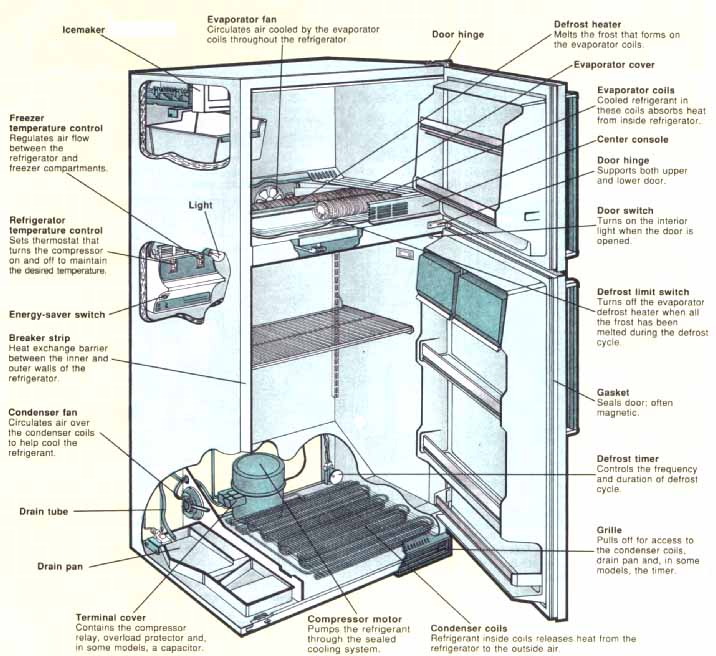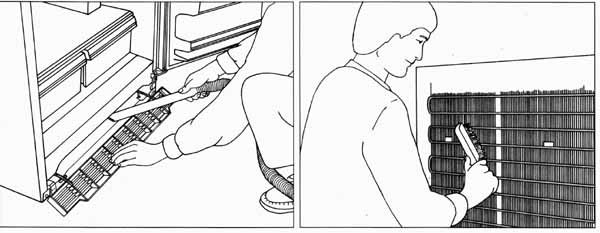Fix-it-Yourself--Major Appliances: REFRIGERATORS (part 1)
| HOME | Troubleshooting | DIY Tips |
|
An average lifespan of fifteen years puts refrigerators among the longest lasting and most trouble-free of all major appliances. All refrigerators work by means of a sealed cooling system. Refrigerant gas, liquefied by high pressure, passes through a narrow capillary tube and enters the evaporator coils inside the refrigerator. Under reduced pressure, it quickly boils into a gas, absorbing heat in the process. This gas flows to the compressor, which pumps it into the condenser coils on the outside of the refrigerator. Now under high pressure, the refrigerant gives off heat to the surrounding air as it returns to a liquid state. The refrigerant then passes back through the capillary tube into the evaporator coils as the cycle of heating and cooling continues. When the desired temperature is reached, the thermostat control turns off the compressor. The sealed cooling system limits the range of jobs that can be tackled by a do-it- Repairs to the compressor, evaporator or condenser require special skills and tools and must be handled by professionals. But many other problems can be diagnosed and repaired without any special tools. Though they chill food the same way, refrigerators vary in style and features. Shown below is a typical two-door, frost-free model with floor-level condenser coils. Variations are described within each repair step. Follow the instructions that most closely fit your machine. - - - Labels/captions of fridge schematic above:
- - - Refrigerators vary mainly in the way they handle the home maker’s bugaboo: frost build frost-free refrigerator has a defrost heater that warms the evaporator coils in both the refrigerator and freezer compartments. Pictured throughout this section, it contains all of the components found in the other two types. A semi-automatic refrigerator has a defrost heater that prevents frost in the refrigerator compartment only; the freezer compartment must be defrosted by hand. A manual refrigerator has no defrost heater and must also be defrosted by hand. To defrost a refrigerator, turn off or unplug the machine and use a hair dryer on a low setting to melt a light layer of frost. For a heavy buildup, place a pan of hot water in each compartment and close the doors. Never hammer at ice buildup or try to pry it away with a sharp tool; this may puncture the evaporator. Regular cleaning prolongs the life of a refrigerator and keeps energy costs down. Brush or vacuum the condenser coils at the bottom or back of the machine regularly. If the coils are greasy, wash them with soapy water. To prevent odors and ice, keep the drain tubes and drain pan clean and unblocked. Using an oven baster, flush the drain tubes with warm water and baking soda (). Wash the compartments, trays, shelves and drain pan twice a year using a water and baking soda solution followed by a clear water rinse. If the power goes out, food will keep in a closed refrigerator for 24 to 36 hours. If the power is out for a longer period, pack the food in dry ice (frozen carbon dioxide). Set the dry ice on heavy cardboard or layers of newspaper, not in direct contact with food. Keep the door closed as much as possible and do not touch the dry ice; it causes frostbite. If food must be removed from the refrigerator or freezer during a repair, place it in the bathtub, layered with newspapers and dry ice. Before starting any repair, always unplug the refrigerator or disconnect the fuse or circuit breaker. When disconnecting electrical parts, mark the locations of wires and terminals to ensure correct reassembly. Before plugging in the refrigerator, wait an hour. This equalizes the pressure in the sealed cooling system, lessening the start-up strain on the compressor. A refrigerator may come equipped with an icemaker, or one may be installed later. To make ice, a solenoid-operated water inlet valve at the back of the refrigerator meters in enough water to fill the ice mold. A thermostat switch inside the icemaker determines when the water is frozen and activates the motor and mold heater (if any) to eject the ice into a bin. A shutoff arm, pushed up by accumulating ice, turns off the icemaker when the bin is full. The Troubleshooting Guide for icemakers appears below. The diagram and repairs begin next. REFRIGERATOR TROUBLESHOOTING GUIDE(match number in POSSIBLE CAUSE column with same number in PROCEDURE column)
DEGREE OF DIFFICULTY: Easy; Moderate; Complex ESTIMATED TIME: Less than 1 hour; 1 to 3 hours; Over 3 hours CLEANING THE CONDENSER COILS Cleaning two types of coils. An accumulation of dirt and dust prevents condenser coils from radiating heat, making the refrigerator cool poorly, run constantly, or even stop completely if the compressor overheats. Clean floor-level coils twice a year (above, left); more often if you have pets. Unplug the refrigerator. Pull off the grille and use a vacuum cleaner with a wand attachment to remove dust and pet hair that accumulate behind the grille. Clean rear-mounted coils (above, right) yearly, using a stiff brush or a vacuum cleaner with a brush attachment. If the coils are greasy, wash them with warm, soapy water, taking care not to drip water on other parts of the refrigerator. CLEANING THE DRAIN AND DRAIN PANCleaning the drain and drain pan. The drain opening may be in the
floor of the refrigerator under the storage drawer (far left), or at
the top of the back wall, behind a pull- off drain trough (near left).
To clean the drain, use an oven baster to force a solution of hot water
and baking soda or bleach into the opening. To clear a stubborn clog,
insert a length of 1/4-inch round plastic tubing into the drain and
push it through to the drain pan below, then pull it out. The drain
pan is located under the refrigerator, behind the front grille. Wash
the pan regularly with a warm baking soda solution. If the pan rattles,
it may be located too close to the compressor; reposition it.
|


